First setbacks for the Muslim Brotherhood
We are continuing the publication of Thierry Meyssan’s new book, « Right Before Our Eyes ». In this episode, the luck of the draw changes hands. US-Egyptian President Mohamed Morsi was overthrown in the wake of gigantic demonstrations, while the invasion of Damascus failed.
This article is an extract from the book Fake wars and big lies. See Contents.
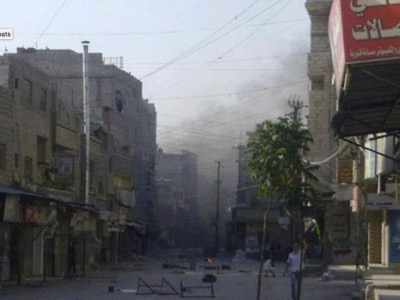
- Despite fielding 40,000 committed men, the Muslim Brotherhood failed to take the Syrian capital. Far from welcoming their « liberators », the population resisted and the operation was a fiasco.
The “Arab Spring” in Syria
As of 4 February 2011, date of the opening of the meeting in Cairo, the coordination of the Arab Spring in Syria was handled by the Facebook account “Syrian Revolution 2011”. The title alone is enough to indicate that the operation was intended to quickly overthrow the Syrian Arab Republic, as had been the case for the other “colour revolutions”, since the objective was not to change the mentalities, but only the leading elites and a few of the country’s laws. On the same day as its creation, “Syrian Revolution 2011” launched an appeal for a demonstration in Damascus which was relayed by al-Jazeera, while Facebook reported tens of thousands of “Followers”. Computer magic. This account was to play a central role over the next five years. Every Friday, the Muslim day for prayer, it dedicated itself to one of the Brotherhood’s objectives.
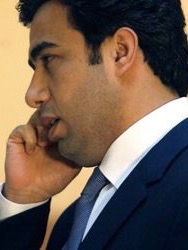
- The Haririst deputy Okab Sakr
On 22 February, John McCain was in Lebanon. He met various leaders of the pro-Saudi Coalition of 14 March, including deputy Okab Sakr, to whom he entrusted the delivery of arms to the Islamists responsible for terrorist attacks in Syria [1]. He then left Beirut and went off to explore the Syrian border. He chose the village of Ersal as the future base of operations.
In spite of the appeals from the mysterious Syrian Revolution 2011 account, it was not until mid-March that events began to heat up in Syria. The Brotherhood gathered in Daraa, a town in the South of Syria, near the border with Jordan. It was reputed for being heavily Ba’athist, and also home to ex-jihadists from Afghanistan and Iraq. The Brotherhood hijacked a demonstration by civil servants who were demanding a pay rise, and began destroying the Palace of Justice. The same day, supervised by Mossad officers, they attacked a centre of Syrian military intelligence outside the town, used exclusively for surveillance if Israeli activity in the occupied Golan Heights.
Reporting on the event, al-Jazeera claimed that the inhabitants of Daraa were protesting after the police had tortured children who had tagged slogans hostile to President Assad. Confusion reigned while the vandals continued the destruction of the town centre. Over the following weeks, three groups of Islamists rambled through the country, attacking poorly-defended secondary targets. The impression of instability was generalised, even though the attacks concerned only three distinct locations at a time. In the space of a few weeks, there were more than 100 deaths, mainly policemen and soldiers.
President Assad’s reaction was the opposite of what was expected – instead of imposing a local Patriot Act, he abrogated the state of emergency which was still in force – Syria is still at war with Israel, which occupies the Golan Heights – and dissolved the State Security Court. He passed a law guaranteeing and organising the right to demonstrate, denounced an operation instigated from overseas, and called on the People to support the Institutions. He convened the Chiefs of Staff and forbade soldiers to use their weapons if there was any risk of causing collateral civilian deaths.
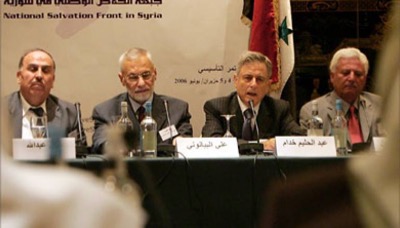
- The Guide of the Syrian Muslim Brotherhood, Ali Sadreddine al-Bayanouni (a refugee in London), allied himself with ex-vice President Abdel Halim Khaddam (a refugee in Paris). The latter fled his country when it was discovered how he and Ghazi Kanaan, the head of the Intelligence services, had hidden the pillage of Lebanon by the Saudi Rafic Hariri.
Taking the President at his word, the Brotherhood attacked a military convoy in Banias (hometown of the traitorous ex-vice President Abdel Halim Khaddam) for several hours, in full view of the population. Fearing that the spectators might be killed or wounded, the soldiers obeyed their President and did not use their weapons. A dozen of them were killed. The sergeant who was commanding the detachment lost both his legs when he covered a grenade with his body to protect his men. The operation was organised from Paris by Khaddam’s Salvation Front and the Muslim Brotherhood. On 6 June, 120 policemen were killed in a similar situation in Jisr al-Shughur.
Demonstrations hostile to the Syrian Arab Republic were held in several towns. Contrary to the image that was propagated by the Western medias, the demonstrators never called for democracy. The slogans they chanted most were – “The People want the régime to fall”, “Christians to Beirut, Alawites to the grave”, “We want a Godfearing President”, “Down with Iran and the Hezbollah”. Several other slogans mentioned “liberty”, but not in the Western sense of the word. The demonstrators were calling for the freedom to practise Sharia law.
At that time, people believed that only al-Jazeera and al-Arabiya were trustworthy sources of information – media that had supported the régime changes in Tunisia and Egypt. They were therefore persuaded that in Syria too, the President would abdicate and that the Muslim Brotherhood would take power. The vast majority of Syrians were witnessing what they thought was a “revolution”, and were preparing for a new Islamist government. It is very difficult to count the number of Syrians who demonstrated against the Republic, or who supported the Muslim Brotherhood. We can only report that hundreds of small-scale demonstrations took place throughout the country, and that the largest of them gathered close to 100,000 people in Hama. [2] Its organisers were received by President Assad in Damascus. When he asked them what they were demonstrating for, they answered that they wanted to “forbid Alawites to enter Hama”. The astonished President – himself an Alawite – ended the interview.
On 4 July in Paris, there was a public conference, organized by the Brotherhood and the Israeli government behind the scenes, to get the French leaders on board. Responding to the appeal of “philosopher” Bernard-Henry Levy and the ex- and future Ministers for Foreign Affairs Bernard Kouchner and Laurent Fabius, [3] representatives from the right, centre, and left, and some ecologists, lent their support to what was presented to them as a struggle for democracy. No one noticed the presence in the room of the real organisers of the event – Alex Goldfarb (advisor to the Israeli Minister for Defense) and Melhem Droubi (world head of external relations for the Brotherhood), who had come specially from Saudi Arabia.
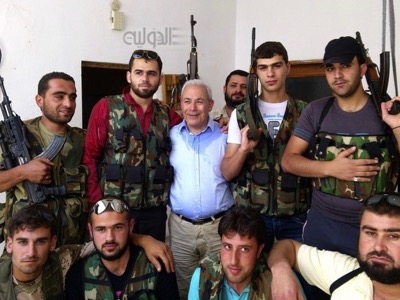
- Burhan Ghalioun left Syria at the age of 24, and pursued a university career in Paris. At the same time, with the help of the NED, he created the Arab Organization for Human Rights in 1983 in Tunisia. When the Algerian Abassa Madani (from the Islamic Salvation Front) left for exile in Qatar, the secular Ghaioun helped him to write his speeches. In June 2011, he participated in the Conference for the National Salvation of the Muslim Brotherhood and, on a proposition from the United States, was elected a month later to the presidency of the Syrian National Council (SNC). As from then, he was paid a salary by the State Department for « representing the Syrian People ».
In August, a Syrian National Council was founded in Istanbul, on the model of the Libyan National Transitional Council. It consisted of long-time expatriates from Syria, others who had recently left, and the Muslim Brotherhood. The bizarre idea that this group was seeking to establish a “democracy” was ostensibly made plausible by personalities from the extreme left wing, such as professor Burhan
Ghalioun, who was named its President. Yet this man had been working for years with the NED and the Muslim Brotherhood. Although he was a layman, he had been writing speeches for Abassi Madani (President of the Islamic Salvation Front of Algeria) since he was exiled in Qatar. This was also the case of George Sabra and Michel Kilo, who had been working with the Brotherhood for more than thirty years, and who had followed the Trotskyists to the NED in 1982. Under the direction of the Libyan Mahmud Jibril, Sabra notably worked on the foreign versions of the children’s TV programme “Sesame Street”, produced by the French Lagardère Media and by al-Jazeera of Qatar, with RAND Corp. researcher Cheryl Benard, wife of Zalmay Khalilzad, US ambassador to the UN and then Iraq. Similarly, human rights careerist Haytham Manna was manager of investments for the Sudanese Brotherhood.
Qatar bought the rotating presidency of the Arab League from the PLO for $400 million. In violation of the statutes, it suspended the Syrian Arab Republic, even though it was a founding member of the organisation. Then it proposed an on-site Observer Mission presided by Sudan (still governed by the Brotherhood). It designated the exhead of the secret services and ex-ambassador to Qatar, General Mohammed Ahmed Mustafa al-Dabi, to direct the work. Every member state sent observers, in order to represent all tendencies. The Syrian Arab Republic agreed to host the League and allowed the Mission to deploy over all its territory. This was the first and only time that a pluralist organisation had gone into the field, met with all the protagonists, and visited the whole country. It was actually the only trustworthy external source of information throughout the whole conflict.
The nomination of General al-Dabi was unanimously saluted by all parties. He had negotiated the separation of Sudan and South Sudan, and was proposed by many Arab states for the Nobel Peace Prize. However, it appeared from a reading of the preliminary reports that the Sudanese had no intention of writing a report made to order, but to conduct an authentic and pluralist investigation. Suddenly, the international media changed their tune, and accused al-Dabi of responsibility for the genocide in Darfur. All those who had approved his nomination now demanded his resignation. The General resisted angrily.
Finally, a status report was published, attesting to the fact that there was no revolution in Syria. The Mission confirmed that the violence had been considerably exaggerated, that the army had withdrawn from the towns, that there was no repression, that the victims were mostly soldiers and policemen, that more than 5,000 prisoners whose names had been transmitted to the authorities had been freed, and that foreign medias who request to cover the events had been allowed to do so.
Qatar, in a fit of anger, paid $2 billion to Sudan to recall General al- Dabi, but he refused to allow the League to nominate his successor. Bereft of its commander, the Mission was dissolved at the beginning of 2012.
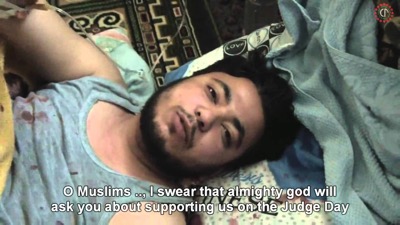
- Young Abou Saleh became a permanent correspondent for France 24 and Al-Jazeera in the Islamic Emirate of Baba Amr (Homs). There he directed the imaginary two-month bombing of the neighbourhood by « régime forces », participated in the sentencing to death of 150 inhabitants of the area, delivered a deathbed address to his spectators (photo), then, suddenly recovered, he set fire to a pipeline, etc. He fled from Paris when the Emirate collapsed, and reappeared later on in Idleb.
Furious at seeing the Syrian Arab Republic pull through, the Brotherhood decided to create an Islamic emirate. After several attempts, they chose a new neighbourhood of Homs, Baba Amr, where tunnels had previously been dug and fitted to ensure a supply route in case of a siege. 3,000 combatants gathered there, including 2,000 Syrian Takfiri. They were members of a sub-group of the Brotherhood, “Excommunication and Immigration”, created under Sadat.
They set up a “Revolutionary Tribunal”, judged and condemned to death more than 150 inhabitants of the neighbourhood, and then cut their throats in public. The rest of the inhabitants fled, with the exception of about forty families. The Takfiri then built barricades at all the points of access to the area, and these were heavily armed by the French Special Forces. The terrorist campaign of the first year gave way to a war of position, in conformity with the plan laid out in 2004 in “The Management of Savagery”. From that point on, the Islamists received weapons from NATO which were more sophisticated than those of the Syrian Army, which had been under an embargo since 2005.
One morning, the Syrian Arab Army entered Baba Amr, whose defences had been de-activated. The French, the journalists and a few leaders fled, to reappear a few days later in Lebanon. The Takfiri surrendered. The war that had just begun seemed to be ending already, like in Lebanon in 2007, when the Lebanese army defeated Fatah al-Islam. But the Islamists were not done yet.
A new operation was being prepared from Jordan, under NATO command. The plan was to attack Damascus in the context of a gigantic psychological operation, but this was cancelled at the last moment. The Islamists who had been abandoned by France in Baba Amr were now decommissioned by the United States, who were discussing a possible sharing of the Middle East with Russia. A promise of peace was signed in Geneva, on 30 June 2012.
The end of the “Arab Spring” in Egypt
In Egypt, the Brotherhood dominated the new parliament, or “constituent assembly,” which was of the opinion that the new Constitution – drawn up specifically to expedite its election – did little more than reiterate a slightly amended old text, although it had been approved by referendum at 77%. It therefore designated a Constituent Assembly of 100 members, this time including 60 Brothers.
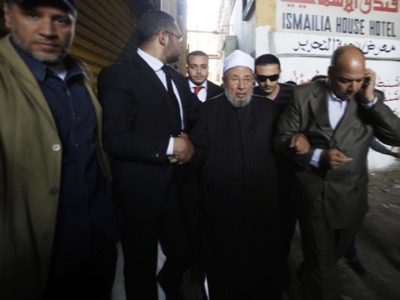
- As soon as President Moubarak resigned, forced by Washington, Sheik Youssef Al-Qaradâwî returned to Qatar in a private jet. Administrator of the Oxford Centre for Islamic Studies presided by Prince Charles, and spiritual advisor of Al-Jazeera, he hosted a weekly programme about the charia. On Tahrir square, he rejected democracy and called for the execution of homosexuals.
The Brotherhood stressed that the young democrats could undermine the power of the army. Its campaign for the Presidential election was the occasion to call for the regeneration of the country by the Qu’ran. Yusuf al-Qaradawi preached that it was more important to fight homosexuals and re-instate the Faith than to fight Israel for the recognition of the rights of the Palestinian People [4]. While the Sunni population massively boycotted the election, the Brotherhood prevented the election from being held in Christian villages and towns, so that 600,000 citizens were unable to vote.
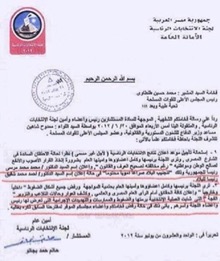
- The Presidential Electoral Commission « confirmed Mohamed Morsi as President of Egypt, in order to avoid a bloody destiny for the country if [it proclaimed] the election of General Ahmed Shafiq ».
However, the election results favoured General Ahmed Shafik, Mubarak’s ex- Prime Minister, who won by a slim margin of 30,000 votes. The Brotherhood then threatened the members of the Electoral Commission and their families until, 13 days later, it decided to proclaim victory for Brother Mohamed Morsi [5]. The “international community” praised the democratic character of the election.

- Press conference at the headquarters of the Muslim Brotherhood with the World Guide of the Brotherhood and President Mohamed Morsi.
Mohamed Morsi was an engineer who had worked for NASA. He had United States nationality and secret defence security clearance in the Pentagon. As soon as he came to power, he began work to rehabilitate and favour his own clan, and to reinforce the bonds with Israel. On the anniversary of Sadat’s execution, he received the assassins at the Presidential palace. He nominated Adel Mohammed al-Khayat, one of the leaders of Gamaa Al-Islamiya, (the group responsible for the 1997 massacre in Luxor), as governor for that district. He persecuted the democrats who had demonstrated against certain aspects of Hosni Mubarak’s politics (but not his resignation). He supported a vast campaign of pogroms by the Muslim Brotherhood against the Christians, and covered up their abuses – lynchings, destruction of the archbishoprics, and the burning of churches. Simultaneously, he privatised major businesses and announced the possible sale of the Suez Canal to Qatar, which was then sponsoring the Brotherhood. From the Presidential palace, he telephoned Ayman al-Zawahiri, world leader of al-Qaeda, at least four times.
Finally, opposition to Morsi became unanimous; excepting the Brotherhood, all political parties, even the Salafists, demonstrated against him. 33 million citizens took to the streets and called on the army to give the country back to the People. Taking no notice of the street, President Morsi ordered the army to prepare to attack the Syrian Arab Republic in order to come to the assistance of the Syrian Muslim Brotherhood. That was to be the final straw.
On 3 July 2013, at the hour that Washington’s offices close for the long weekend of the Independence Day national holiday, the army carried out a coup d’état. Mohamed Morsi was imprisoned, while the streets became a battlefield – the Muslim Brotherhood and their families on one side, and the law enforcement agencies on the other.
The war against Syria
It is said that “in politics, promises only bind those who believe in them”. One month after the Geneva 1 conference and the peace agreement, and a few days after the “Friends of Syria” Conference in Paris, war was authorised once again. Instead of a NATO action supported by a few jihadists, this was a jihadist attack supported by NATO. Its code name was “Damascus Volcano and Syrian Earthquake”.
An army of 40,000 men, trained in Jordan, crossed the border and charged towards the Syrian capital, at the same time as a terrorist bombing killed top Syrian leaders at a meeting of the National Security Council. The army and the intelligence services lost their commanders in the attack.
The jihadists were mercenaries who had been recruited from among the poor of the Muslim world. Many of them did not speak Arabic, and had received only one week of military training. Some of them believed they were fighting Israelis. After suffering considerable losses, they retreated.
In the long war which followed, the Syrian Arab Army attempted to defend its population centers, against the jihadists, who tried to make life impossible in the vast expanses of the desert. They enjoyed an infinite supply of reinforcements. Every month, new fighters arrived to replace the dead and the deserters. All the petty criminals of the Muslim world came to try their luck for a few hundred dollars a month. Recruitment centres were opened publicly in countries like Tunisia and Afghanistan, and more discreetly in countries like Morocco and Pakistan. However, the fatality rate of these legionnaires was extremely high.
In July 2013, according to Interpol, some very sophisticated escape operations were carried out in nine states in order to free the Islamist leaders and transfer them to Syria. For example:
 On 23 July, between 500 and 1,000 prisoners escaped from the prisons in Taj and Abu Ghraib (Iraq).
On 23 July, between 500 and 1,000 prisoners escaped from the prisons in Taj and Abu Ghraib (Iraq).
 On 27 July, 1,117 prisoners escaped from Kouafia prison in Benghazi district, Libya by a riot inside the prison combined with an attack from outside.
On 27 July, 1,117 prisoners escaped from Kouafia prison in Benghazi district, Libya by a riot inside the prison combined with an attack from outside.
 On the night of 29 to 30 July, 243 Taliban escaped from the prison in Dera Ismail Khan in the Pakistani tribal areas.
On the night of 29 to 30 July, 243 Taliban escaped from the prison in Dera Ismail Khan in the Pakistani tribal areas.
The Syrian Arab Army cremated most of the combatants’ corpses, while retaining those that could be identified. They were sent back to their families. Several states discreetly set up repatriation networks, for example Algeria, with the Emir Abdelkader Foundation. Yet the Syrian Arab Army still holds more than 30,000 corpses that were identified, but never claimed.
Those Western states which had at first sent Special Forces recruited from amongst their own soldiers with double nationality – generally Muslims with origins in the Maghreb – later organised their own networks to recruit jihadists. Thus, in France, a network was set up in prisons with Salafist mosques, like the one in the Rue Jean-Pierre Timbaud in Paris. These several thousand individuals were added to the tens of thousands from the “Greater Middle East”. Although we do not know for certain how many people took part in the war, it is estimated that the total number of jihadists fighting in Syria and Iraq, both locals and foreigners, has been more than 350,000 since 2011. This is more than any regular army of the European Union, and twice that of the Syrian Arab Army.
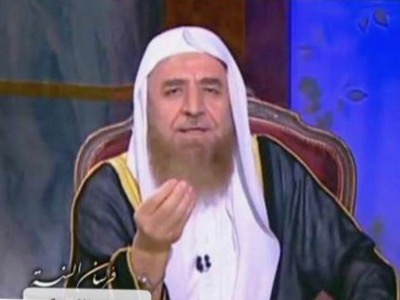
- On the Saudi television channel al-Safa, Syrian Sheikh Adnan Al-Arour called for the massacre of the Alaouites. He was to become the religious reference of the Free Syrian Army (FSA).
The ideological unity of the jihadists was guaranteed by the “spiritual head of the Free Syrian Army”, sheikh Adnan al-Aroor. This colourful personality was able to reach a vast public by way of his weekly TV programme. He inflamed passions by calling for the overthrow of the tyrant, and supported a paternalistic, authoritarian vision of society. As time went on, he drifted towards sectarian appeals for the massacre of Christians and Alawites. He originally he came from a family of delinquents, betrayed his brothers to the police, and escaped a prison sentence by joining the Syrian Arab Army. As a non-commissioned officer, he was arrested for raping young recruits. He then fled to Saudi Arabia, where he became a sheikh in the service of Allah.

- Meeting at the US National Security Council , on 13 June 2013 at the White House. We recognise Gayle Smith (second from the right) and Brother Rashad Hussain (fourth from the left). The National Security Advisor, Tom Donilon, also took part in the meeting, but is not seen in the photo. Above all, we may recognise the representative of the Muslim Brotherhood and assistant of Youssef al-Qaradâwî, Sheik Abdallah Bin Bayyah (second from the left with a turban).
The jihadists usually received basic weaponry, and had access to an unlimited supply of ammunition. They were organised in katibas or brigades, small units of a few hundred men, whose commanders received ultra-sophisticated equipment, notably portable communication kits relaying live satellite images of the movements of the Syrian Arab Army. They were therefore fighting an asymmetrical war against the Syrian Arab Army, who were certainly better trained, but whose weapons all dated from before 2005, and who had no access to satellite imagery.
In contrast to the Syrian Arab Army, whose units were all coordinated and placed under the authority of President Bashar al- Assad, the jihadist katibas were continually skirmishing between themselves, as on all battlefields where rival “warlords” struggle for superiority. However, all the factions received reinforcements, arms, ammunition and intelligence from a single central command, NATO LandCom, situated in Izmir (Turkey), and whom they were therefore obliged to obey. But the United States had great difficulty in making this system work, because many of the participants were attempting to conceal their operations from their allies – for example, the French in secret from the British, or the Qataris to the detriment of the Saudis.
As soon as a territory was evacuated by the Syrian Arab Army, the jihadists who occupied it dug in. They built tunnels and bunkers. The Saudis had sent the billionaire Osama Bin Laden to Afghanistan because he was a specialist in public works. He supervised the construction of tunnels in the mountains – or more exactly, the enlarging of subterranean riverbeds. In Syria, NATO civil engineers came to supervise the construction of gigantic lines of defence, comparable to those of the Central Powers during the First World War.
(To be continued …)
Translation
Pete Kimberley
Pete Kimberley
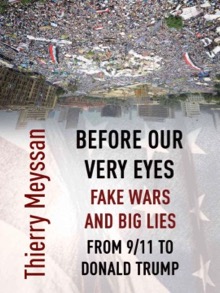 This book is available in English langage.
This book is available in English langage.
[1] “Lebanese MP directing arms traffic to Syria”, Translation Pete Kimberley, Voltaire Network, 13 December 2012.
[2] Anti-Assad protesters in Homs, alleged “cauldron of the revolution,” were paid youngsters who had been bussed in, according to local witnesses. ISIS IS U.S., p. 127.
[3] Coincidentally, of course, all three of these politicians are Jewish, or of Jewish extraction, as were both the major French presidential candidates, Nicholas Sarkozy and Dominique Strauss-Kahn, until the latter was eliminated by scandal.
[4] Global Mufti: The Phenomenon of Yusuf Al-Qaradawi, Bettina Graf & Jakob Skovgaard-Petersen, Hurst (1999); Hamas and Ideology. Sheikh Yūsuf al-Qaraḍāwī on the Jews, Zionism and Israel, Shaul Bartal and Nesya Rubinstein-Shemer, Routledge (2018).
[5] “Egypt Presidential Elections Fraud In Favor Of Mohamed Morsi”, Voltaire Network, 20 June 2012.



Geen opmerkingen:
Een reactie posten